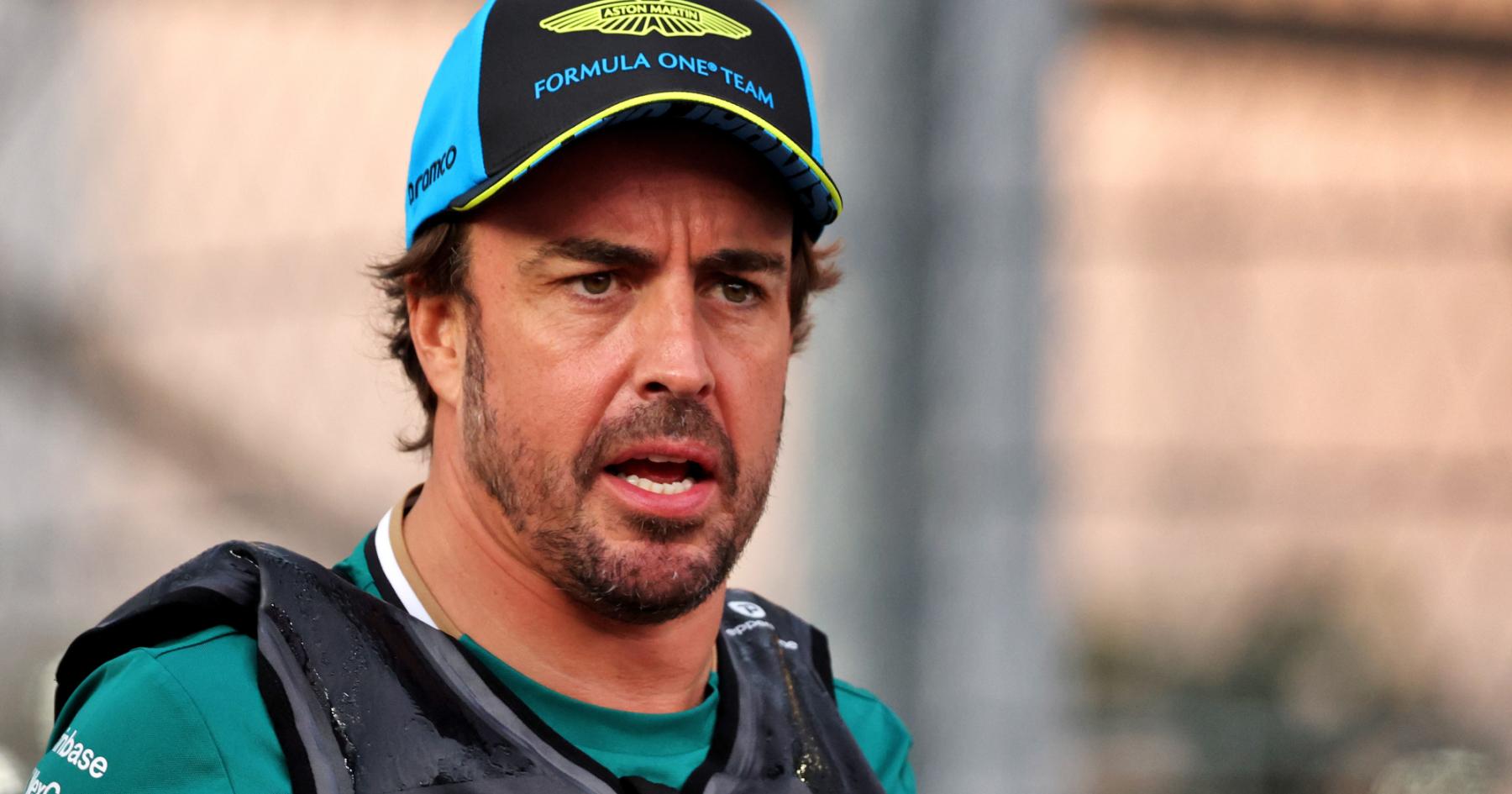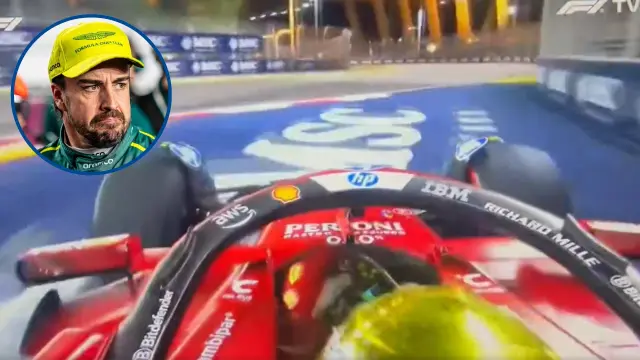The final stages of the Singapore Grand Prix were meant to deliver a predictable conclusion to a race light on action. Yet, in the span of just three desperate laps, one of the most incredible, edge-of-your-seat battles in recent Formula 1 history unfolded—a visceral, high-stakes drama that almost no one outside of the two competing garages got to see.
This was not a tale of clinical precision or flawless strategy. This was a story of survival, of a seven-time World Champion fighting a mechanical catastrophe, and a two-time champion, a man possessed, charging across the asphalt like a predator sensing a kill. It was Lewis Hamilton versus Fernando Alonso, separated by a failing machine and a lifetime of shared history, battling for seventh place. And in a monumental display of broadcast incompetence, the world was treated to the sight of Zack Brown hugging his staff while the actual racing evaporated from the screen.
The result was a masterclass in how to completely ruin a defining moment in a sport built on televised spectacle, leading to immediate and furious backlash from fans, commentators, and, most tellingly, one of the legends directly involved in the action.

The Fading Ferrari: Lewis Hamilton’s Desperate Fight for Survival
The crisis for Lewis Hamilton began subtly, then accelerated into a terrifying collapse. Running comfortably in seventh place in his Ferrari, the veteran driver had amassed a seemingly unassailable 5.2-second gap over Fernando Alonso’s Aston Martin as the race entered its final stages on Lap 58. For the Ferrari team, it was a straightforward points finish. Everything was, apparently, under control.
Then, disaster struck. Hamilton’s brakes began to fail, a terminal decline in performance on one of the calendar’s most demanding street circuits. What followed was a dramatic, harrowing struggle against a machine literally turning against its master.
The time loss was immediate and alarming. On Lap 59, Hamilton bled 3 seconds to the chasing Alonso. On Lap 60, that loss ballooned to 5 seconds. But it was Lap 61 that saw the situation spiral into genuine peril. In a single, excruciating tour of the Marina Bay circuit, Hamilton surrendered a staggering 3.2 seconds. This wasn’t just a performance deficit; this was a safety emergency unfolding live on track.
The danger was visually undeniable. Sparks, often the harbinger of critical mechanical stress, were flying from Hamilton’s car during braking zones as the system struggled—and failed—to cope with the G-forces and heat of the street race. With the ability to slow his car compromised, Hamilton was forced into a desperate dance of correction and transgression. He was repeatedly forced to take liberties with the track limits, running wide at corners simply because the car would not decelerate enough to stay within the white lines. The drive became a primal fight, not to hold position, but simply to keep the car on the asphalt and avoid a catastrophic failure.
It was a performance of raw, untamed bravery—a driver instinctively managing a terminal fault through pure experience and will—yet, tragically, it was all but invisible to the millions watching at home.
The Charging Bull: Alonso’s Relentless Masterclass
While Hamilton was locked in a life-or-death struggle with his own machinery, 43-year-old Fernando Alonso was executing one of the most intense, inspiring charges of his storied career. Alonso, a driver with an almost supernatural ability to sense weakness, could smell the hydraulic fluid in the water. He understood, without needing a radio message, that something critical was wrong with the Ferrari ahead, and he reacted with the ferocity of a driver half his age.
Lap after lap, Alonso pushed the limits of the Aston Martin, finding pace that defied the car’s known performance ceiling. The 30-second gap that had once separated the two titans of the sport began to disappear in huge, confidence-sapping chunks. This was the legendary ‘El Matador’ at his finest, driving with the kind of focused intensity that cemented his reputation as one of the most formidable, tenacious competitors in Formula 1 history.
By the time the two reached the final lap, the incredible had happened: Alonso had closed the 30-second chasm down to a minuscule four-tenths of a second. It was an epic convergence, a final-lap showdown featuring two of the sport’s most decorated names, one fighting a wounded lion’s battle for survival, the other sensing his moment of blood-in-the-water glory.
This was the drama. This was the narrative tension that Formula 1 is designed to create. It was the moment the world should have been holding its breath.

The Scandalous Omission: A Broadcast Blunder That Ignored History
Yet, here is where the story takes its frustrating, scandalous turn. Instead of broadcasting this incredible, historic, and nail-biting climax—the two legends separated by mere car lengths, a failing car, and one man’s indomitable will—the television director chose to focus elsewhere.
As Hamilton desperately nursed his broken car toward the finish line, with Alonso breathing down his neck and the gap shrinking to almost nothing, viewers were subjected to extended, unnecessary footage of crowd shots, fans cheering in the grandstands, and most offensively, static camera shots of Zak Brown, the McLaren CEO, hugging his team members and celebrating their Constructors’ Championship success.
The TV director, in that moment, failed their fundamental duty: to show the race.
The reaction from the sport’s core audience was not just disappointment; it was immediate, unadulterated fury. Social media platforms erupted with criticism. Viewers, many of whom pay premium prices for F1 TV subscriptions or Sky Sports packages, felt robbed of the defining moment of the day.
One widely circulated comment captured the mood perfectly: “F1 TV race directors showing Zack Brown for about an hour instead of showing us Hamilton vs. Alonso at the end, just do your job.” Another fan articulated the precise frustration, stating: “The F1 TV director showing us the wrong thing again. Give the people what they want. Nobody wants to see Zack Brown hugging someone; we want to see Alonso and Hamilton being mad men on the last lap.”
Even the professional commentators, forced to watch the global feed like the rest of the world, voiced their disbelief. Sky Sports’s lead commentator, David Croft, expressed his frustration live on air, telling viewers that they should be seeing the breathtaking Hamilton-Alonso battle instead of the crowd celebrations. The fact that the official broadcasters were powerless to intervene and equally annoyed speaks volumes about the systemic failure of the production.
This singular moment of drama was the one thing that made the Singapore Grand Prix noteworthy, a race already criticized for being light on overtaking and high-octane action. To miss the only piece of genuine, unmanufactured drama was not just a mistake; it was an unforgivable abdication of duty that enraged the fanbase.

Alonso’s Fury and the FIA’s Just, Yet Tainted, Ruling
The raw, unfiltered emotion that was denied to the viewing public was later captured in Fernando Alonso’s radio transmissions. Having crossed the line a mere 0.48 seconds behind the crippled Ferrari, Alonso’s frustration boiled over.
“I cannot fucking believe it!” he exclaimed, repeating the phrase multiple times over the team radio. The sheer shock and disbelief that he had closed such a massive gap only to run out of corners was palpable. His next question, however, introduced a vital element of concern and scrutiny: “Is it safe to drive with no brakes?”
Alonso later elaborated on his frustration, telling Spanish broadcaster Dazzen that he was informed of the situation only two laps from the end. His attention immediately turned to the track limits violations Hamilton had been forced to commit to keep his car on the road. Alonso’s logic was simple and compelling: “When you don’t have brakes, you can’t really go off the track, because we all have to stay on the track with or without brakes.”
The stewards, thankfully, listened.
Following the race, they investigated Hamilton’s track limits infractions. Hamilton confirmed that he had indeed left the track on multiple occasions while attempting to manage his brake issues. However, the stewards maintained that a mechanical failure, while sympathetic, was not considered a justifiable reason for exceeding the track limits under the sporting regulations. Hamilton was subsequently handed a 5-second penalty.
The ruling dropped Hamilton from his hard-fought P7 to P8, promoting Alonso to seventh place. Justice, of a sort, was served to the two-time World Champion. But the penalty, while correcting the final result, could not correct the fact that the most exciting, emotionally charged few minutes of the entire Grand Prix had been completely sidelined by poor judgment in the TV director’s booth.
The Systemic Failure of Formula 1’s Global Feed
This incident highlights a systemic, and increasingly infuriating, problem with Formula 1’s television coverage that goes far beyond a single director’s error. For years, fans have voiced constant complaints about crucial on-track action being missed in favor of irrelevant “fluff”: crowd shots, celebrity guests, static views of team personnel, or needless paddock shots.
The irony is staggering. Formula 1 boasts a technological arsenal that is second to none, featuring high-definition onboard cameras, stunning helicopter perspectives, and trackside coverage that could show multiple battles simultaneously. There is no technical limitation preventing the broadcast from delivering the action. The problem is purely down to poor editorial decision-making, a consistent and baffling prioritization of narrative over racing.
Furthermore, the structure of the global feed—which is centrally provided by Formula 1 and which external broadcasters like Sky Sports are forced to use—means that the situation is virtually unfixable by third parties. Experienced commentators, the very people whose job it is to follow the race and guide the viewer, are rendered helpless when the television director makes a poor choice.
As Formula 1 continues its global expansion and its push for new audiences, spearheaded by documentary success and social media buzz, it cannot afford to squander the raw drama that is the lifeblood of the sport. The Hamilton-Alonso battle was a visceral reminder of what makes F1 special: the clash of titans, the fight against the elements, and the incredible feats of human skill.
To miss, or deliberately censor, such a magnificent moment—the singular, defining highlight of an otherwise forgettable race—is not just frustrating for existing fans; it actively denies potential new viewers the very spectacle that would convert them. Formula 1 has all the ingredients for incredible theater; it must now ensure that the people holding the camera finally decide to point it at the stage.